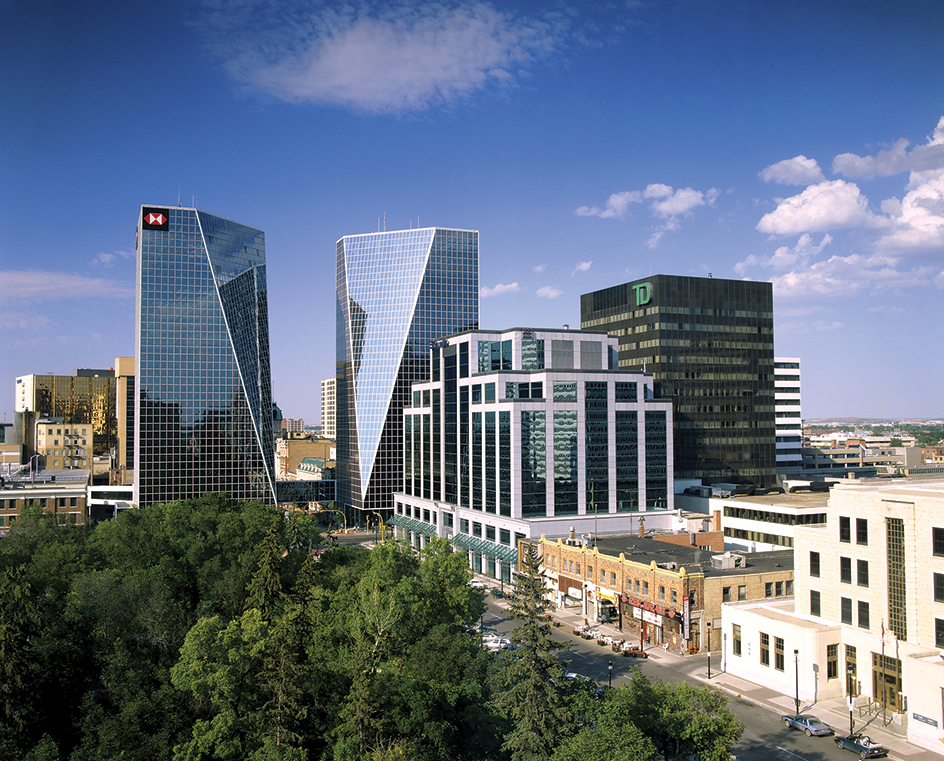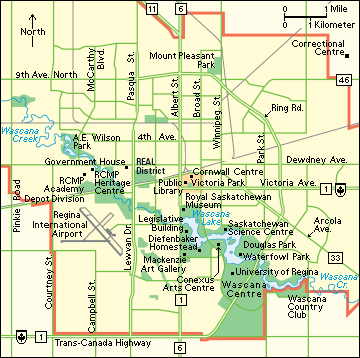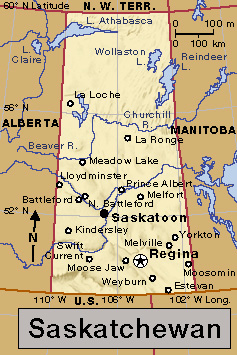Regina, << rih JY nuh, >> is the capital and second largest city of Saskatchewan. Only Saskatoon is larger. Regina is on a plain in southern Saskatchewan, about 100 miles (160 kilometers) north of the Canadian-United States border. The Latin word regina means queen, and Regina is sometimes called the Queen City of the Plains.

Regina is the commercial, financial, and industrial center of Saskatchewan. The city lies in the heart of Canada’s richest wheat-growing region. Until the 1960’s, Regina served mainly as a marketing and supply center for this region. Since then, it has become a manufacturing center as well.
Before white settlers came, the Cree Indians often camped on a site near what is now Regina. They butchered buffalo there, and the bones piled up. The Indians called the place Oskunah-kasas-take, which the white settlers translated as Pile o’ Bones, and the stream that ran by it became known as Wascana Creek. In 1882, the Canadian government chose a small settlement on the creek as the new capital of what was then the North-West Territories. At the time, the settlement was also called Pile o’ Bones. The site was only a treeless plain, but it lay near the new Canadian Pacific Railway. This railroad, which linked eastern and western Canada, attracted the first settlers to Pile o’ Bones. In 1882, they renamed the settlement Regina, in honor of Queen Victoria of England.
The city.
Regina covers 69 square miles (179 square kilometers). Wascana Creek winds through the city. Southeast of the downtown area, a dam widens the creek into an artificially created lake, Wascana Lake. Wascana Centre, a 2,300-acre (930-hectare) belt of parks and public buildings, surrounds the lake. Buildings in Wascana Centre include the Legislative Building, where the Saskatchewan legislature meets; the University of Regina; the Royal Saskatchewan Museum; and the Conexus Arts Centre.

Many of Regina’s people have some English ancestry. Other large ethnic groups include people of French, German, Irish, or Scottish descent.
Economy.
Regina has hundreds of manufacturing plants. They account for more than a third of Saskatchewan’s industrial production. The city’s chief manufactured products include cement, fertilizer, and steel.
The rich agricultural region around Regina makes the city a center for the distribution of farm machinery. Viterra, one of the largest grain-handling and marketing companies in the world, has its North American headquarters in the city.
The oil fields of southern Saskatchewan have helped make Regina an important oil center. The city has oil refining facilities. The petroleum pipeline that links the Alberta oil fields with ports on the Great Lakes runs through Regina.
Regina is the trade and distribution center for the surrounding region. Many of the city’s workers have jobs in wholesale or retail trade. Many others work for the city, provincial, or federal government. The Royal Canadian Mounted Police has its training headquarters there.
The Canadian National Railway and the Canadian Pacific Railway connect Regina with the East and West coasts. Regina lies on the Trans-Canada Highway, and Regina International Airport is just west of the city center.

Education and cultural life.
An elected Board of Education supervises Regina’s public school system. The city also has a number of private and parochial schools. The University of Regina is a coeducational school that grants bachelor’s, master’s, and doctor’s degrees. First Nations University of Canada, which has a campus in Regina, is the only university in Canada that is controlled by the country’s native peoples.
The Regina Public Library operates a main library and a number of branch libraries. The Saskatchewan Provincial Library is also in the city. Regina has a daily newspaper, the Leader-Post.
The Conexus Arts Centre includes two theaters and a convention hall. The Regina Symphony Orchestra performs at the center. The Globe Theatre, a professional company, stages productions in its own theater in downtown Regina.
Wascana Waterfowl Park features hundreds of water birds and animals. The Royal Saskatchewan Museum features galleries that trace the human history and geological history of Saskatchewan.
The MacKenzie Art Gallery displays paintings and sculpture. The Royal Canadian Mounted Police Heritage Centre features exhibits that show how the Mounties brought law and order to Canada’s frontier. The Mounties’ chapel, part of which dates from 1883, ranks as one of Regina’s oldest buildings.
Queen City Ex, an annual festival held in late July and early August, celebrates Regina’s frontier days. The festival includes parades, rodeos, and square dances. The Saskatchewan Roughriders play in the Canadian Football League. The Lawson Aquatic Centre features an Olympic-sized swimming pool. The 102-acre (41-hectare) REAL (Regina Exhibition Association Limited) District hosts conventions, concerts, trade shows, and other events.
Government.
Regina has a council-manager form of government. The voters elect a mayor and 10 council members to the city council. The council establishes city policies and appoints a professional administrator called a city manager to carry them out. The mayor and council members serve four-year terms. The city gets more than half its revenue from property taxes.
History.
The Cree Indians hunted buffalo in what is now the Regina area before Europeans arrived. In 1857, the British explorer John Palliser visited the site and reported that it was unfit for farming. But in 1880, a Canadian botanist named John Macoun realized the Regina plains would make fertile wheatlands. He persuaded the Canadian Pacific Railway Company to build its transcontinental railroad across the area.
The railroad reached Regina in 1882, and the Canadian government chose the site for the new capital of the North-West Territories. Regina actually became the new capital in 1883. Battleford, the former capital, lay more than 225 miles (362 kilometers) north of the railroad and was too hard to reach. Also in 1882, the North-West Mounted Police (now the Royal Canadian Mounted Police) established its headquarters in Regina. By 1903, when Regina was incorporated as a city, it had 3,000 people.
In 1905, the province of Saskatchewan was created with Regina as its capital. Settlers from eastern Canada, Europe, and the United States poured into the area’s rich wheatlands. The city grew into an important trade and supply center for the surrounding farms. By 1911, Regina’s population had reached 30,000.

A cyclone destroyed much of Regina in 1912, but the city was quickly rebuilt. During World War I (1914-1918), the Regina area produced huge quantities of wheat for the Allies. But the demand for wheat dropped after the war, and falling wheat prices created a depression in Saskatchewan.
The city’s economy continued to slump during the Great Depression of the 1930’s, and many workers were unemployed. By 1937, about a fifth of the population was receiving welfare payments.
In 1933, the Co-operative Commonwealth Federation (CCF), a socialist political party, held its first national convention in Regina. The CCF adopted a statement, known as the Regina Manifesto, that called for the end of capitalism. In 1944, the CCF gained control of the provincial government, which thus became the first socialist government in Canada. Regina served as CCF headquarters from 1933 until the party joined with a group of Canadian trade unions to form the New Democratic Party in 1961.
During the 1950’s and 1960’s, the discovery of underground resources—chiefly potash, used for fertilizer, and petroleum—strengthened the region’s economy. Many new industries came to Regina, and the city’s economy became less dependent on a good annual wheat crop. Regina’s population nearly doubled during this period, rising from 71,000 in 1951 to 139,000 in 1971.
A construction boom changed Regina’s skyline during the 1960’s. Three of the city’s tallest structures went up—the 16-story Avord Tower, the 16-story Canadian Imperial Bank of Commerce, and the 13-story Saskatchewan Power (now SaskPower) building.
Regina faced financial problems in the 1970’s. Taxes failed to provide enough money to run the city government, and the public transportation system operated at a loss. Regina’s population grew during the 1970’s. It reached 162,613 by 1981. Another construction boom in Regina began in the mid-1970’s. A new City Hall opened in 1976. Two provincial government office buildings were constructed in 1979—the sprawling T. C. Douglas Building and the Saskatchewan Government Insurance Tower.
In 1980, a huge, enclosed shopping mall called the Cornwall Centre was completed. In 1983, the Bank of Montreal Building opened near the Cornwall Centre.
